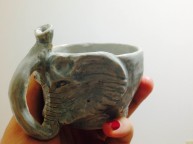For my CIP this semester, I participated in Zen meditation. Prior to KCJS, my knowledge of Zen was limited to what I had seen in manga or anime or a few brief descriptions from various classes. I remember very clearly hearing in one business class when I was a freshman that many American professionals came to Japan for a couple weeks every year to study Zen and focus their minds by learning the Japanese methods. Honestly, I found the statement questionable and perhaps of a slight orientalist bent, and I can’t say that has changed much from my experience with Zen.
As a practice, even now, I can’t say that I understand Zen or have really gotten very good at it. As such, I also can’t say that I’ve noticed any distinct improvements to my mindset. There are a couple misconceptions about Zen that I would like to clear up. From various media, you see Zen meditation as a monk slapping your shoulder with a stick, if you do anything wrong. I had the impression that getting slapped was a bad thing and that you got slapped if you moved around or weren’t focusing on Zen. So, the first time, I stayed still and endured brutal agony from losing sensation in my lower limbs after an hour and then trying to stand up; the position is not the comfiest. The priest explained to the group later that you’re supposed to bow to the priest to get him to slap you with the stick. Then, after getting slapped, you can readjust your posture—which I took to mean let your blood circulate again. Sure enough, it helps a lot.
The discomfort does seem to be an important aspect of the meditation. Focusing on doing so many difficult to maintain aspects of the meditation at once means your mind has no chance to wander off or fret about something else. So, even if though don’t come out centered and on target for everything in the next week, I do enjoy an hour of not really thinking or worrying about anything, which is actually pretty nice. In KCJS, you build up a lot of stress. While you’re in Kyoto, you’re balancing learning Japanese, various other classes, and trying to experience Japan as much as possible. Sometimes, you where yourself out trying to do it all, and having a CIP where you can just let it all go rather than feel yet another thing to stress out about helps.
As for my interactions with people during Zen, I have to say they’re rather limited. You have an hour to meditate, and you do that in silence. Afterwards, everyone goes to another room for ten minutes and you get to enjoy a small snack and some tea. During that time, there is a little talking, mostly on the part of the priest, he talks to just about everyone briefly, while everyone waits their turn for the snack and green tea. When everyone is done, the priest escorts you out of the temple and ushers you home. I haven’t experienced that much in terms of the same people showing up. A couple people show up fairly regularly, but I’d say the vast majority show up once and you never see them again. From what I understood of many conversations I’ve overheard, a lot of people do it, because they’re touring Kyoto and know that there are temples where you can practice Zen, so they like to give it a try.
My actual time to talk to and interact with people is very quietly while waiting for tea and for a few minutes if we walk in the same direction leaving the temple. All told, I’d say that amounts to a maximum of twelve or fifteen minutes per session, provided I find someone interested in talking. A lot of my conversations amount to their curiosity in a foreigner attending a Zen meditation lesson, so I usually have the same conversation topic rehearsed: what have I done in Kyoto, where do I live, why did I come to Kyoto, and what am I studying now. So those conversations are usually bust. If I’m lucky, they’re interested in going abroad or have gone abroad, or they know a bit about some interest of mine.
There are a couple things I wish I did in order to increase my chances to interact with Japanese people during CIP. For one thing, the priest looks pretty busy, but he seems like a friendly person. I regret not trying to speak to him more, and I’d recommend trying to do so. Another thing that could increase talking chances is to arrive earlier than the appointed time. People tend to gather before hand and stand around doing nothing. It’s not a bad chance to try talking them up.

